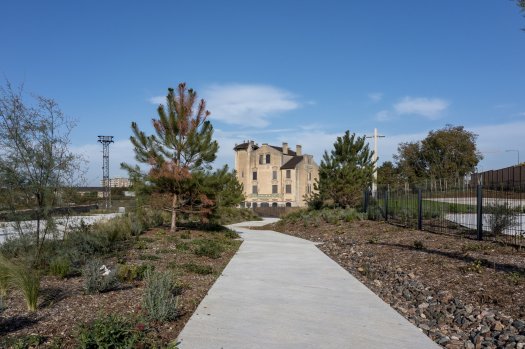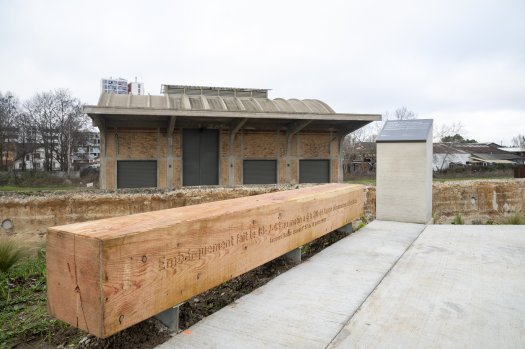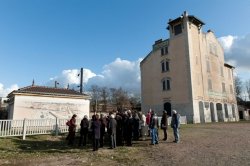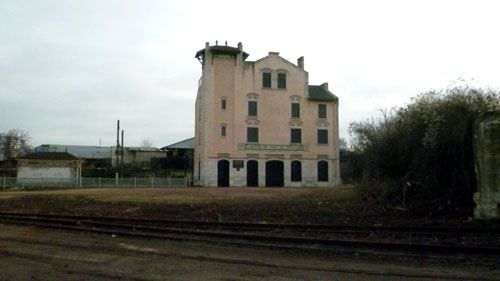

Seine-Saint-Denis has several places of remembrance related to the Second World War. Among them, the Bobigny train station is now a Memorial. This historical site is to be discovered during an instructive and moving visit (free of charge), to understand and remember what the deportees who transited through this station experienced. Before these tragic events, the station was a place of transit for travelers and goods.
January 18, 2023: opening to the public of the Bobigny Memorial after several years of work.
July 18, 2023: inauguration of the site for the 80th anniversary of the departure of the first convoy
The entrance used during the war has been recovered and marks the transition from urban life to the memorial of the station. A reception pavilion has been created and will provide historical information about the place.
The Esplanade of the present also called "garden" gives a global view from this promontory
The memorial area includes the goods hall, the kiosks, the passenger building and the railroad tracks. On this site, the 74 deportation convoys that left from France and the 21 convoys that left from Bobigny are displayed along the tracks.
On this site 75 steles are erected in memory of all the convoys of Jewish deportees who left France between 1942 and 1944 for the death camps.
Various spaces: Court of witnesses, Esplanade of memory, Court of goods
The Level Crossing: pedestrian crossing between the Espace de la mémoire and the Jardin sauvage. This place will be dedicated to the various events organized on the site
The site of the former deportation station of Bobigny is open from Wednesday to Sunday.Free entrance.
Opening hours from 9:30 am to 12:30 pm and from 2 pm to 5 pm
The visit is free (or guided on request). Audioguides and application to download on site.
Guided tour of the Bobigny Deportation Station Memorial
Duration: 1h15 on average - Open air visit.
The meeting point is on the railway bridge - 69-151 avenue Henri Barbusse - Bobigny
School groups should contact the Shoah Memorial in Drancy to organize the visit to the Bobigny site: 01 42 77 44 72
At the end of the 19th Century, a railway stop was built on the circular line in Bobigny. Its soaring population growth transformed this rural village into a small city at the beginning of the 20th Century. Local elected officials called therefore for the construction of a real passenger station. This station was built in 1928. The architecture was both a mix of the rationalist movement and the old spa style ressembling three stations built on the line Saintes to Royan in western France. The upper floors of the building were for rail workers housing. The ground floor included the station officer’s office and the waiting room. In the early 1930s, a freight station was set up to serve the factories located around the station. At the end of the 1930s, the passenger station had to be closed because of insufficient traffic. Nevertheless, rail workers continued to live on the upper floors.
 A few years later, Bobigny station was re-activated during the German occupation. It became the new starting point for deportation convoys. Before July 1943, the convoys left from le Bourget station. Bobigny station was more convenient logistically speaking: its location close to a railway crossroads in Noisy-le-sec still allowed for easy connection to the eastern network. Bobigny station was also less exposed to the risks of bombing. The relocation of the starting point of the convoys was decided by Aloïs Brunner, the new commander of the Drancy camp. He considered that Bobigny station was more practical because buses could have direct access to the tracks. Furthermore, there were no other passengers.
A few years later, Bobigny station was re-activated during the German occupation. It became the new starting point for deportation convoys. Before July 1943, the convoys left from le Bourget station. Bobigny station was more convenient logistically speaking: its location close to a railway crossroads in Noisy-le-sec still allowed for easy connection to the eastern network. Bobigny station was also less exposed to the risks of bombing. The relocation of the starting point of the convoys was decided by Aloïs Brunner, the new commander of the Drancy camp. He considered that Bobigny station was more practical because buses could have direct access to the tracks. Furthermore, there were no other passengers.
From that time, Bobigny station became the starting point for 21 convoys of jewish deportees from July 1943 to August 1944. A total of 22 407 people, men, women and children, were squeezed into cattle trucks for Auschwitz-Birkenau extermination camp. They were kept in the train for more than 50 hours while their convoy went through Epernay, Châlons-sur-Marne, Bar-le-Duc, Metz, Sarrebrück, Mannheim, Dresde, Görlitz, Neisse, Coser, Katowice before arriving at the end of this terrible journey: the location of the “Final Solution”, Auschwitz-Birkenau. Nearly all of them died in the train or in the camp.
In 1941, Hermann Göring authorized Reinhard Heydrich to begin preparations for a “whole solution of the Jewish question”. The “Final Solution” intended to exterminate the European Jews by asphyxiation in the gas chambers, by firearms or by any other means. Auschwitz-Birkenau was to have a central role in the German plan for extermination of the Jews. This camp was one of the largest with its gas chambers and crematoriums.
Each convoy consisted of 20 to 25 wagons. It transported one thousand Jews, around 50 people (men, women and children) per wagon with bread and a little water. A Nazi police escort send from Germany was responsible for guarding the deportees.
A single convoy, number 73, did not go to Auschwitz but to Kauna in Lithuania and to Tallinn in Estonia. We do not know the reason for this exception. Only 22 of the 800 men deported in this convoy survived.
On 31st July 1944, the last convoy left Bobigny station with near to 1300 Jews including 330 children. Hundreds of miles from there, Allied troops were entering into Avranches in Normandy.
On 7th August 1944, the SS Aloïs Brunner fled by train with 51 hostages. He took refuge in Syria where he became adviser to the President Hafez el-Assad. He never was found to be judged in front of a tribunal. Aloïs Brunner was condemned to the death in absentia in France in 1954. In 1987, he said in an interview to the Chicago Sun Times that he had no regrets. “I have no regrets, I would do it again…”. Rumours are still being circulated that he died in the nineties in Syria.
After the Second World War, a commemorative plaque was installed on the station building to mark the action of railway workers against Nazi occupation. At the beginning of the 90’s, it was replaced by another one remembering the deportation of French Jews. In the 50’s, the station site had been leased by the SNCF (the French railway company) to a metal scrap dealer who ceased all activity in 2005. On that date the site was classified on the French historic monument list. In collaboration with a number of partners within the SNCF and the Foundation for the Memory of the Shoah, the City of Bobigny has embarked upon a project of turning this station into a place of history and memory. Indeed, this station is one of the few places that was witness to deportation and that is still in its original state. This project aims to preserve this heritage while respecting its authenticity and enhancing its historical and symbolical value. The wild vegetation that is growing on a part of this railway and industrial site, will be part of the project.
